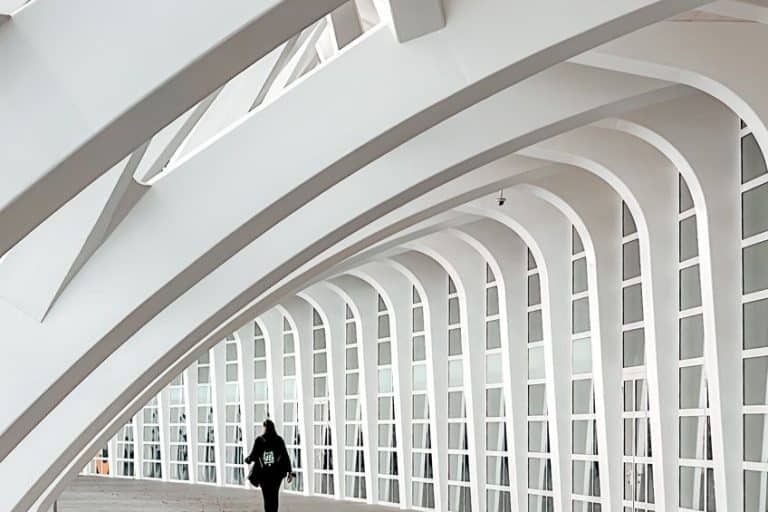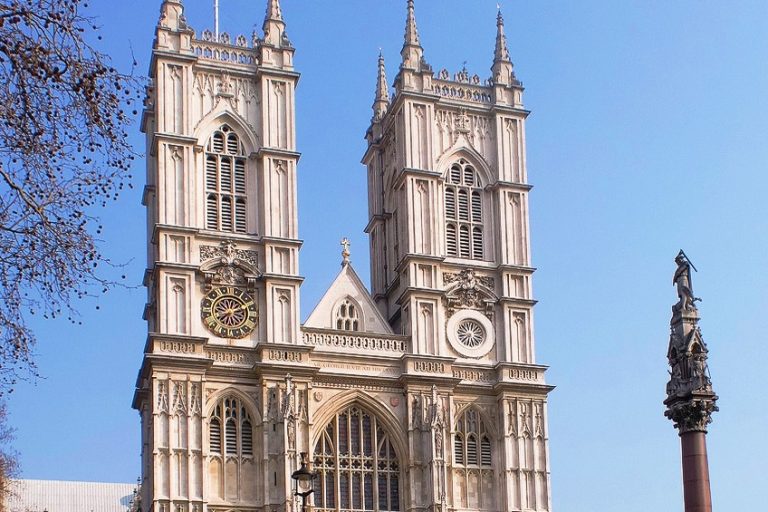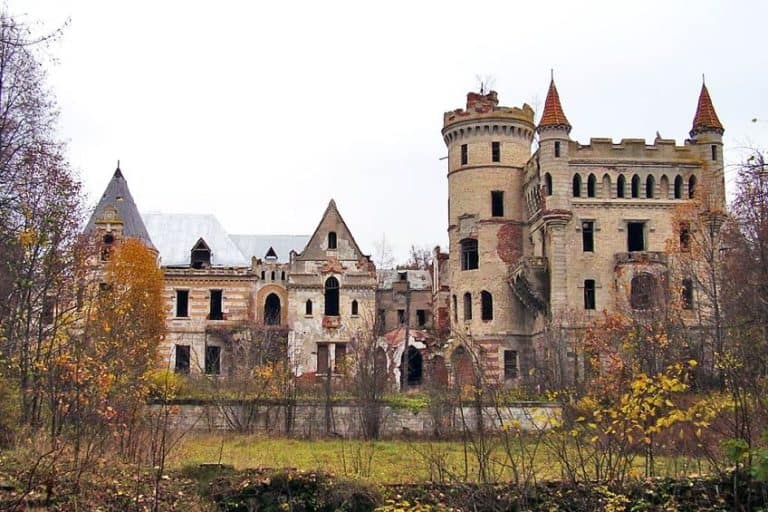Beaux-Arts Architecture – Discover These Timeless Triumphs
There have been many stunning examples of architectural styles in the world, and one of the most gorgeous of all the architectural styles is Beaux-Arts architecture. This style, which originated in France, soon moved across the world and became a popular style until the 20th century. Today, we are going to examine Beaux-Arts architecture by discussing some of its history, the major characteristics of Beaux-Arts architecture, and a number of Beaux-Arts architecture examples. This should provide those who are interested with a decent overview of this stunning variety of architecture. If this sounds like something you would enjoy, start reading and see what you can learn about Beaux-Arts architecture!
A Look at Beaux-Arts Architecture
Beaux-Arts architecture was a style of architecture that had a relatively long run. It originated in the 1830s and managed to survive until the end of the century, but it didn’t entirely fade away. It managed to creep its way into the 20th century for several decades until it did also eventually fade away. However, it has remained a popular style that used various elements of Classical architecture, and some of the styles that had been inspired by it, to create something traditional yet new.
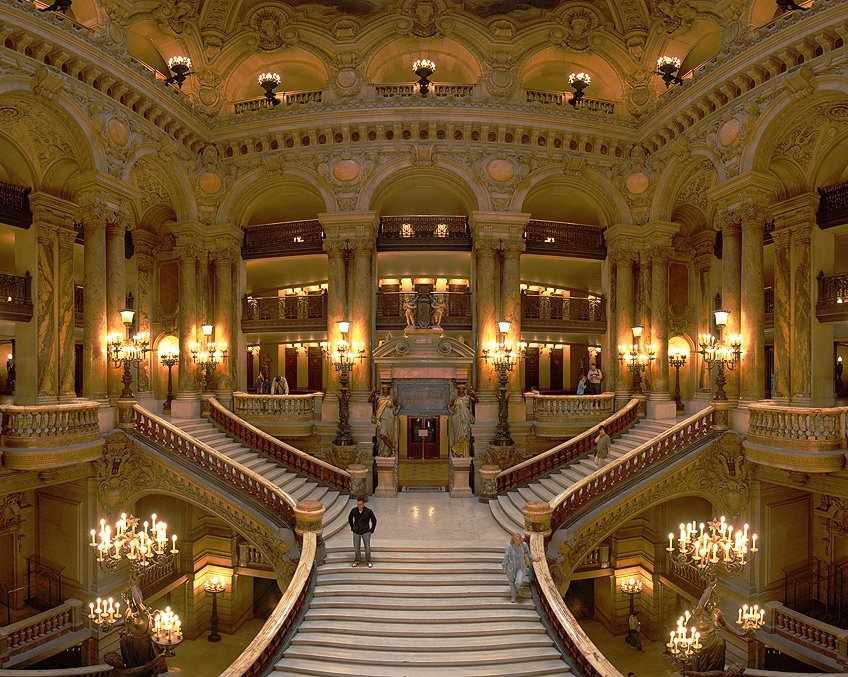
The style drew heavily upon French Neoclassical architecture but incorporated a variety of elements that it took from Baroque and Renaissance architecture. In addition to this, it was known for its more modern use of materials, but not quite to the same extent as the later Modernist movement. However, it can be seen as something of a precursor to it in terms of the use of materials, but not in the sensibilities of its design.
Summary of Beaux-Arts Architecture
Learning more about Beaux-Arts architecture is worth our time, but for those who may not have that kind of time, this is a summary of the major points of Beaux-Arts architecture. These points do not capture the full scope of Beaux-Arts architecture though, and this should be kept in mind.
- Beaux-Arts architecture blended older styles. This style made use of a number of different architectural styles, such as Neoclassical, Renaissance, and Baroque architecture. It is often seen as an ornate style that tried to mimic more Classical styles of architecture.
- Beaux-Arts architecture used modern materials. While Beaux-Arts architecture did attempt to use a more Classical style, it did so by incorporating more modern materials into its design. For instance, many Beaux-Arts buildings used steel and glass in their design and construction.
- Beaux-Arts architecture originated in France. This particular architectural movement began in Paris, France. In more specific terms, this style originated from the École des Beaux-Arts schools. These were very influential schools that espoused these particular designs.
This short and sweet summary of Beaux-Arts architecture should give a good, generalized overview, but it does not tell you as much as you could know about this style. So, if you would like to know a lot more, then you can keep reading.
Next up, we will have a look at some of the origins of Beaux-Arts architecture.
The History of Beaux-Arts Architecture
The Beaux-Arts style, as a whole, emerged out of the prevailing Neoclassical period that was prevalent in the continent at the time. It originated in Paris during the first half of the 19th century at the École des Beaux-Arts school. This particular school was considered to be one of the most important of all the art schools in the continent at the time, and this style would come to be associated with the Second Empire period in France and, in terms of the United States, it would often come to be associated with the Gilded Age.
The earliest years of the Beaux-Arts period can be traced to the 1830s, but the style would only gain in popularity as the decades continued on.
The eclectic style of Beaux-Arts architecture, which will be discussed in more detail in the next section of this article, contributed to its place as a highly sought-after architectural style that could be incorporated into many examples of civic and public structures. For instance, some of the best-known Beaux-Arts buildings include libraries, universities, governmental buildings, museums, and so on. The Beaux-Arts architectural style was seen as a pioneering form of architecture because of its use of modern materials, as will be explored more below. It valorized the kinds of new technologies that were being developed at the time and would become something of a precursor to certain elements found in Modernist architecture.
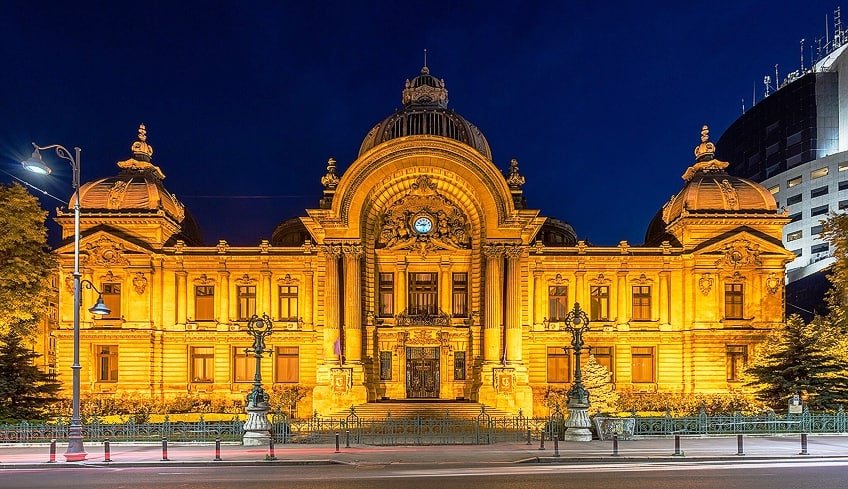
However, the Beaux-Arts period had mostly come to an end by the start of the 20th century, although there were still elements of the style being used as late as the 1940s. The Beaux-Arts architectural period was a stunning one in the history of Western architecture, but its highly grandiose use of ornamentation and scale would ultimately see it being at odds with the later minimalism of Modernist architecture. Regardless of that fact, it has remained one of the most stunning periods of Western architectural history and one of the best-known styles from the 19th century.
The Characteristics of Beaux-Arts Architecture
Beaux-Arts architecture is a truly stunning example of architecture, and it would go on to become one of the most ornate styles since the end of the Baroque era. The reason for this was that this particular architectural style incorporated elements of Classical architecture that were taken from Roman sources while also adding elements that had been developed during the Neoclassical, Renaissance, and Baroque periods. This allowed for a far more ornate design than those that had been more popular at the time, and as this particular style would eventually give way to the more minimalist sensibilities of Modernist architecture, it was one of the last highly ornate styles.
Some of the major elements that are associated with Beaux-Arts architecture in general include the use of highly detailed designs.
This would typically come in the form of ornate façades, cornices, and columns. The incorporation of Classical elements, such as a general dedication to ideas around symmetry and proportionality would have a large influence on the design and development of Beaux-Arts buildings. One of the central elements of Beaux-Arts architecture was its dedication to craftsmanship. Another of the important characteristics of Beaux-Arts architecture was its use of more modern construction materials. While glass had been in use for centuries, the more prolific use of it in Beaux-Arts architecture examples would come to exemplify this style. In addition to this, modern materials like steel were used in far greater proportions in this architectural style over those that had come before, but not to the same extent as would later be seen in Modernist architecture.

In terms of more baseline structural elements, many Beaux-Arts buildings incorporated flat roofs alongside domes, arched windows and doors, the use of columns, colonnades, and other Classical elements, sculptures and reliefs, and elaborate grand staircases. These kinds of elements came together to produce a grandiose and highly elaborate style that was dedicated to the use of symmetrical and ordered designs that followed formal patterns while ultimately calling attention to Classical architecture in general. While Beaux-Arts architecture was an attempt to return, in some sense, to a Classical style, it was also highly eclectic in its incorporation of elements that, while they were often Classical in their inspiration, had significantly deviated from the original styles that came from ancient Rome.
These elements would operate together to transform Beaux-Arts architecture into one of the most stunning and detailed examples of an architectural style since the Baroque period’s extensive dedication to highly ornate and overly decorated designs.
Beaux-Arts Architecture Examples
Below, we will have a quick look at a small selection of some of the best-known Beaux-Arts buildings. There are a great many other fantastic Beaux-Arts architecture examples in the world, but, alas, we do not have the time for each and every one of them. However, the Beaux-Arts buildings below should give a good overview of this particular, and incredibly beautiful, architectural movement.
14 Prince’s Gate (1849) in London
| Architect | Harvey Lonsdale Elmes (1814 – 1847) |
| Date Constructed | 1849 |
| Function | Private residence |
| Location | London, United Kingdom |
14 Prince’s Gate is one of the older Beaux-Arts architecture examples in the United Kingdom and it is located in London. This structure was constructed in the mid-19th century and would have several roles over its lifetime. For instance, it served as the residence of American ambassadors and later as the Independent Television Authority, and even later the Royal College of General Practitioners, headquarters. However, it has since returned to its existence as a private residence. Buildings can go through many different iterations, especially when they have been around for a particularly long time.

When it comes to this structure being an example of a Beaux-Arts building, the design can be seen in the façade and several interior aspects of the building as a whole. The exterior of the structure makes use of a stately design that is reminiscent of many Beaux-Arts architecture examples, and the interior includes a grand staircase, marble columns, and a number of instances of elaborate detailing. All of these aspects of the structure make it a great example of Beaux-Arts architecture in the United Kingdom.
Budapest Nyugati Station (1877) in Budapest
| Architect | August de Serres (19th century) |
| Date Constructed | 1877 |
| Function | Train station |
| Location | Budapest, Hungary |
The Budapest Nyugati station is a fantastic instance of a Beaux-Arts building in Budapest. The structure was designed, from the very beginning, as a train station and so its purpose has never deviated. One of the most interesting things about its construction was that the company that headed up the actual building of the structure was the Eiffel Company, of Eiffel Tower fame.
This train station has since become one of the three main train stations in the city and allows for many rail connections as a hub station.
As for the design of the structure, it is a great example of some of the stunning Beaux-Arts buildings out there. It incorporates a number of materials that are often associated with Beaux-Arts architecture, such as marble and large glass windows. In terms of the actual design of the structure, it is also grandiose and elaborate. It has monumental sculptural designs and uses a variety of Classical architectural elements. However, the building is undergoing renovation projects, but the Beaux-Arts design of the building is likely to remain even if it is altered to some extent.
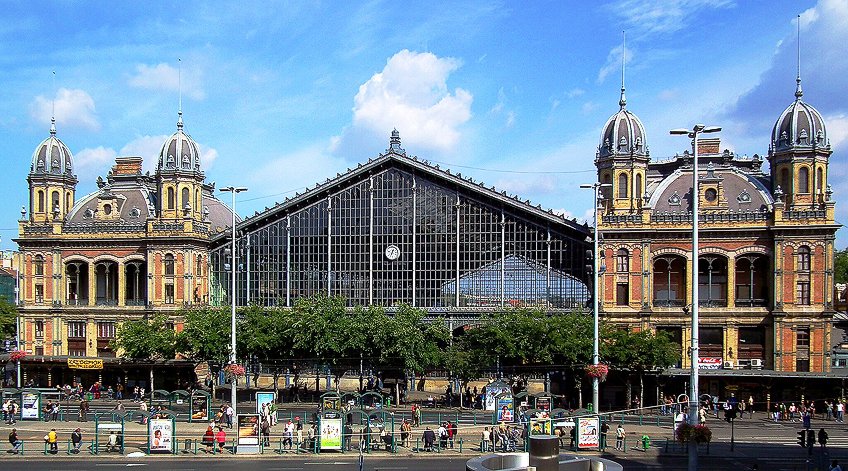
Grand Palais (1897 – 1900) in Paris
| Architect | Charles Girault (1851 – 1932) |
| Date Constructed | 1897 – 1900 |
| Function | Museum complex |
| Location | Paris, France |
The Grand Palais is one of the best-known Beaux-Arts architecture examples in the world. This style originated in Paris, and so it is reasonable to assume that some of the most famous of all Beaux-Arts buildings would be located in the city. The site serves as a museum complex at the moment, but it also has a large exhibition hall. It is also an important location in terms of the history of the city as it was unveiled in the Exposition Universelle of 1900. It has retained its position as one of the most gorgeous instances of Beaux-Arts architecture in the city ever since its construction came to an end.
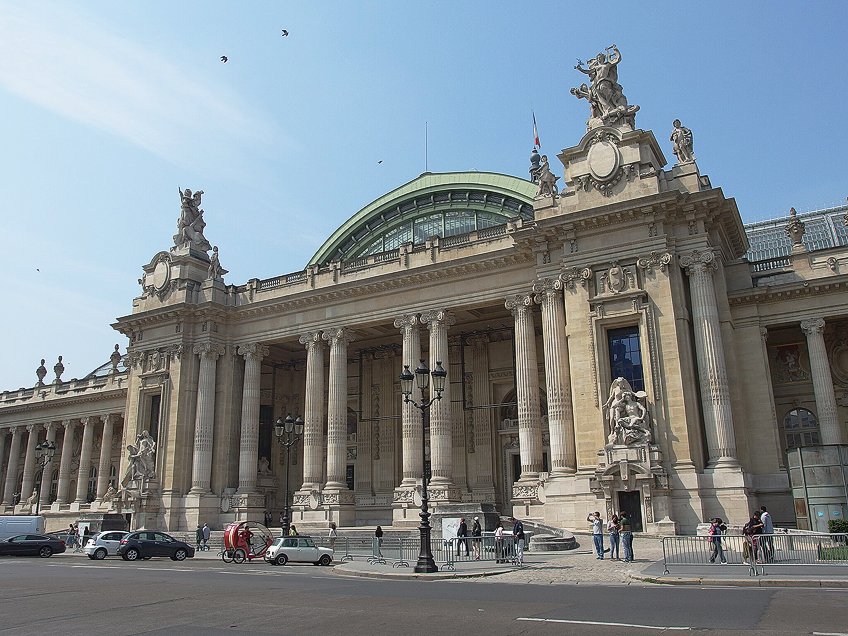
The building was designed as a large-scale venue that could be used to host a variety of artistic events, and because of this intended use, it was constructed in dedication to French artistry in general. The building, as a result, incorporates a highly ornate stone façade, a number of glass vaults, and modern materials, such as a steel frame and the use of reinforced concrete. This building is often considered to be one of the great masterpieces of the Beaux-Arts architectural style, and its incorporation of varying elements, such as those taken from Renaissance and Baroque architecture, has solidified its place as one of the most important sites in French Beaux-Arts architectural history.
New York Public Library Main Branch (1897 – 1911) in New York City
| Architect | John Merven Carrère (1858 – 1911) and Thomas Hastings (1860 – 1929) |
| Date Constructed | 1897 – 1911 |
| Function | Research library |
| Location | New York City, United States |
The New York Public Library Main Branch is one of the best-known libraries in the United States, and it is also considered to be the flagship building of the public library system of the city. The name of the building is technically the Stephen A. Schwarzman Building, but it has generally been called the Main Branch. This particular library is considered to be one of the most important research libraries in the country, and it has also come to be seen as an exemplary example of the Beaux-Arts architectural style in the United States.
The building has also seen expansion and renovation over the decades since its completion.
In terms of Beaux-Arts buildings, the Main Branch is a superb example of this style. It makes use of Classical architectural concepts, uses highly detailed and ornate ornamentation, incorporates monumental sculptural designs, and has a large marble façade that has become one of the most famous Beaux-Arts architecture examples in the United States. Some of the most stunning aspects of the design of this structure include the large glass and cast-iron dome that has become one of the best instances of Beaux-Arts architecture in the world. This structure has remained a gorgeous example of the kind of designs that were possible during the Beaux-Arts period.

Edificio Metrópolis (1907 – 1911) in Madrid
| Architect | Jules Février (1842 – 1937) and Raymond Février (20th century) |
| Date Constructed | 1907 – 1911 |
| Function | Office building |
| Location | Madrid, Spain |
The Edificio Metrópolis building is one of the best-known Beaux-Arts buildings in Spain, and it is located in Madrid, which is already known for some of the most stunning structures in the city. In terms of this particular structure, it has served as an office building since it was first designed. In the beginning, it was developed as the primary office space of the insurance company known as La Unión y el Fénix. However, over the years, it has changed hands, and it is currently owned by Metrópolis Seguros. Regardless of its position as an office building, it has remained one of the most superb examples of Beaux-Arts architecture in the city.
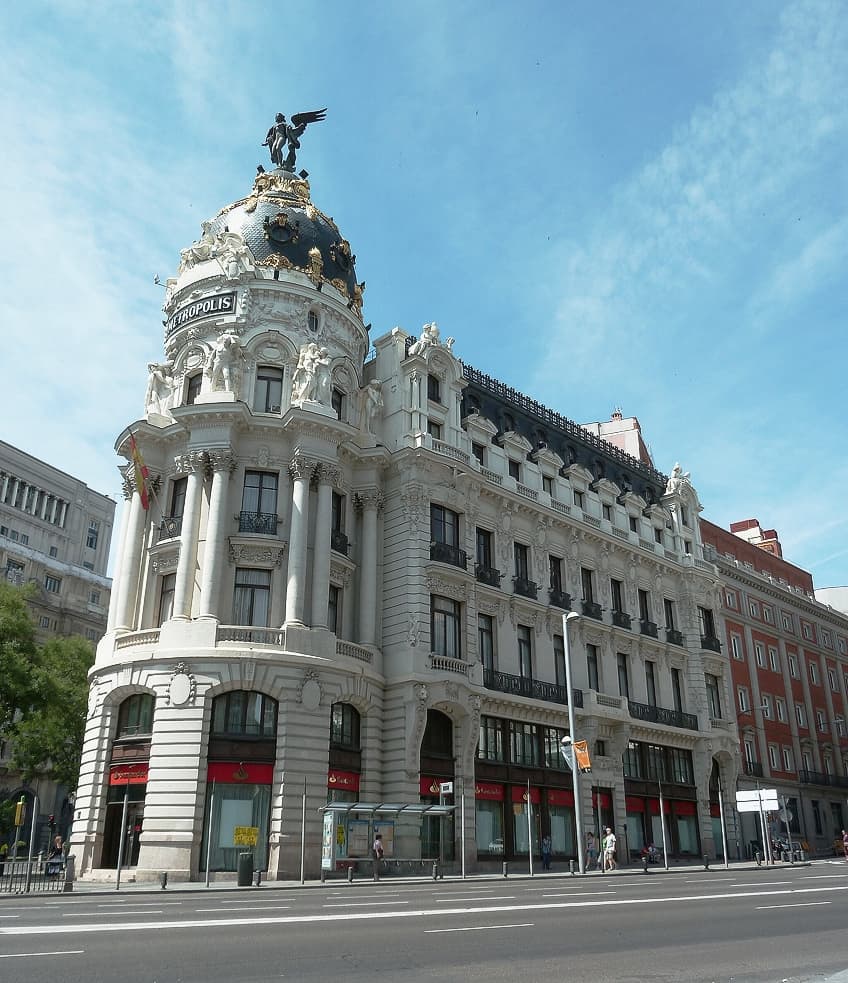
This Beaux-Arts building makes use of a Neo-Renaissance-style façade that incorporates a number of Corinthian columns that are highly ornate in their design. There is also a dome at the front of the building that makes use of gold-covered leaves that adorn the exterior surface. It is highly detailed, makes use of a variety of ornamental figures, and it incorporates an immensely detailed colonnade on the upper floors. The building brought the architects immense fame at the time of its construction, and one of the most famous of all the aspects of this Beaux-Arts building was its use of large statues that represented different sectors of the economy.
With that final Beaux-Arts architecture example, we have arrived at the conclusion of this examination of this particularly ornate style of 19th-century architecture. We have discussed the history of Beaux-Arts architecture, some of the primary characteristics of the form, and a number of Beaux-Arts buildings. While this has been a rather short look at Beaux-Arts architecture in general, it should provide a good explanation of the style for those who were unfamiliar with it before. There are many other Beaux-Arts buildings in the world that you should check out if you found this to be interesting!
Frequently Asked Questions
What Is Beaux-Arts Architecture?
This is an architectural style that arose out of several different styles. It incorporated a number of different styles at the time, such as Neoclassical, Renaissance, and Baroque architecture, while also making use of more modern materials than those that had traditionally been used at the time. This French style soon spread around Europe and the world, and would go on to have an especially large impact on American architecture. This style is still known for its stunningly ornate designs.
Where Did Beaux-Arts Architecture Originate?
This type of architecture saw its origins in France. In more specific terms, it arose from the École des Beaux-Arts schools. These schools had their start in Paris and would have a strong influence on architecture and the arts. The styles that came from these institutions would make their way around the world with time. The United States saw significant influence in its early architecture from Beaux-Arts architecture in general.
What Are the Primary Characteristics of Beaux-Arts Architecture?
Some of the primary characteristics of Beaux-Arts architecture include aspects taken from Classical architecture, like columns and pediments. In addition to this, the Beaux-Arts buildings often made use of symmetrical layouts, highly detailed ornamentation, and the use of modern materials. This allowed the structures that adopted a Beaux-Arts architectural style to have Classical roots while incorporating newer materials, like glass and steel, into their design. All of these elements have, together, contributed to Beaux-Arts architecture being seen as one of the most ornate styles of the 19th century.
What Are Some of the Most Famous Beaux-Arts Buildings?
There are many Beaux-Arts architecture examples across Europe and the United States, and some of the most famous include 14 Prince’s Gate (1849) in London, the Grand Palais (1897 – 1900) in Paris, and the New York Public Library Main Branch (1897 – 1911) in New York City. This is far from a complete list of the kinds of buildings that made use of Beaux-Arts architectural methods and designs. There are many more that can be found by those who are interested in examining some Beaux-Arts buildings.
Who Are Some of the Most Famous Beaux-Arts Architects?
There have been many architects who made use of the Beaux-Arts architectural style, such as Richard Morris Hunt, Charles Follen McKim, and Daniel Burnham. However, Beaux-Arts architecture would have a major influence in Europe and the United States during its period of dominance, and so there have been many more architects who have been inspired by Beaux-Arts architecture in general over the decades and centuries.
Justin van Huyssteen is a freelance writer, novelist, and academic originally from Cape Town, South Africa. At present, he has a bachelor’s degree in English and literary theory and an honor’s degree in literary theory. He is currently working towards his master’s degree in literary theory with a focus on animal studies, critical theory, and semiotics within literature. As a novelist and freelancer, he often writes under the pen name L.C. Lupus.
Justin’s preferred literary movements include modern and postmodern literature with literary fiction and genre fiction like sci-fi, post-apocalyptic, and horror being of particular interest. His academia extends to his interest in prose and narratology. He enjoys analyzing a variety of mediums through a literary lens, such as graphic novels, film, and video games.
Justin is working for artincontext.org as an author and content writer since 2022. He is responsible for all blog posts about architecture, literature and poetry.
Learn more about Justin van Huyssteen and the Art in Context Team.
Cite this Article
Justin, van Huyssteen, “Beaux-Arts Architecture – Discover These Timeless Triumphs.” Art in Context. December 13, 2023. URL: https://artincontext.org/beaux-arts-architecture/
van Huyssteen, J. (2023, 13 December). Beaux-Arts Architecture – Discover These Timeless Triumphs. Art in Context. https://artincontext.org/beaux-arts-architecture/
van Huyssteen, Justin. “Beaux-Arts Architecture – Discover These Timeless Triumphs.” Art in Context, December 13, 2023. https://artincontext.org/beaux-arts-architecture/.





